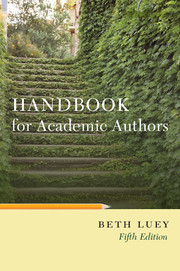Book contents
- Frontmatter
- Contents
- Illustrations
- Preface to the Fifth Edition
- Preface to the Fourth Edition
- Preface to the Third Edition
- Preface to the Second Edition
- Preface to the First Edition
- Chapter 1 The Publishing Partnership
- Chapter 2 Journal Articles
- Chapter 3 Revising a Dissertation
- Chapter 4 Finding a Publisher for the Scholarly Book
- Chapter 5 Working with Your Publisher
- Chapter 6 Multiauthor Books and Anthologies
- Chapter 7 Finding a Publisher for the College Textbook
- Chapter 8 Working with Your Textbook Publisher
- Chapter 9 Books for General Readers
- Chapter 10 The Mechanics of Authorship
- Chapter 11 Costs and Prices
- Chapter 12 Born Digital
- Bibliography
- Index
Preface to the Second Edition
Published online by Cambridge University Press: 02 December 2010
- Frontmatter
- Contents
- Illustrations
- Preface to the Fifth Edition
- Preface to the Fourth Edition
- Preface to the Third Edition
- Preface to the Second Edition
- Preface to the First Edition
- Chapter 1 The Publishing Partnership
- Chapter 2 Journal Articles
- Chapter 3 Revising a Dissertation
- Chapter 4 Finding a Publisher for the Scholarly Book
- Chapter 5 Working with Your Publisher
- Chapter 6 Multiauthor Books and Anthologies
- Chapter 7 Finding a Publisher for the College Textbook
- Chapter 8 Working with Your Textbook Publisher
- Chapter 9 Books for General Readers
- Chapter 10 The Mechanics of Authorship
- Chapter 11 Costs and Prices
- Chapter 12 Born Digital
- Bibliography
- Index
Summary
Soon after the first edition of this book appeared, it became clear that publishing practices were changing so rapidly that I needed to begin thinking about a new edition. The most significant change has been in the expanded use of computers for composition and desktop typesetting. A clear majority of academic authors write with computers, and the practice of typesetting from authors' disks has moved beyond the experimental stage.
This edition therefore has a new chapter, Chapter 10 [Chapter 11 in the third edition and Chapter 12 in the fourth and fifth editions], about using the computer and about electronic publishing: databases, CD-ROMs, and the like.
Another change has occurred in the structure of the publishing industry, which has become increasingly global. Commercial scholarly publishing has a greater presence in the United States because of the expansion of British and European houses into the U.S. market both through the opening of new offices and by the acquisition of U.S. firms. Although the long-term implications of internationalization remain unclear, it seems important to provide more information about commercial scholarly publishing and about the practices of transatlantic publishers. You will find most of this information in Chapter 4, but it appears throughout the book wherever it is relevant.
My own experience has expanded over the past three years to include editing the journal Book Research Quarterly, retitled Publishing Research Quarterly in 1991. As a result I have expanded Chapter 2 to add what I have learned.
- Type
- Chapter
- Information
- Handbook for Academic Authors , pp. xv - xviPublisher: Cambridge University PressPrint publication year: 2009



